Sony Cyber-shot DSC-H1
Review Date: October 31st 2005
|
Image Quality
All of the sample images in this Review were taken using the 5M Fine mode, which gives an average image size of around 2Mb - 2.5Mb.
Noise
There are 4 ISO settings available on the Sony Cyber-shot DSC-H1 which you can select at any time if the camera is in either the Program, Shutter-priority, Aperture-priority and Manual exposure modes. Here are some 100% crops which show the noise levels for each ISO setting:
ISO 64 (100% crop) |
ISO 100 (100% crop) |
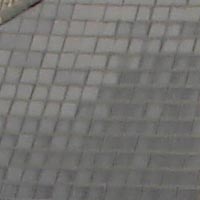 |
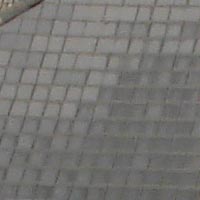 |
ISO 200 (100% crop) |
ISO 400 (100% crop) |
 |
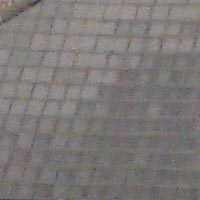 |
The noise levels look fine at ISO 64 and 100, but there's already some noise starting to appear at ISO 200 and the image quality has deteriorated quite a lot at ISO 400.
Sharpening
Here are two 100% crops which have been Saved as Web - Quality 50 in Photoshop. The right-hand image has had some sharpening applied in Photoshop. The out-of-the camera images are a little soft at the default setting of Normal and benefit from some further sharpening in a program like Adobe Photoshop. Alternatively you can increase the in-camera sharpening.
Original
100% Crop
|
Sharpened 100% Crop |
 |
 |
 |
 |
File Quality
The Sony Cyber-shot DSC-H1 has 2 different file quality settings available, with Fine being the highest quality option. Here are some 100% crops which show the quality of the various options, with the file size shown in brackets.
|
5M
Fine (2,135Kb)
|
5M
Standard (1,160Kb)
|
 |
 |
Chromatic Aberrations
The Sony Cyber-shot DSC-H1 handled chromatic aberrations extremely well during the review. Only very high-contrast situations like those shown below caused any problems, with very limited purple fringing present around the edges of over-exposed parts of the image.
|
Example
1
|
Example
2
|
 |
 |
Macro
The Sony Cyber-shot DSC-H1 offers a Macro setting that allows you to focus on a subject that is 2 cms away from the camera. The first image shows how close you can get to the subject in Macro mode (in this case a compact flash card). The second image is a 100% crop.
|
Macro Shot (click to view full-sized image) |
100% Crop |
Flash
The flash settings on the Sony Cyber-shot DSC-H1 are Auto, Forced Flash, Slow Synchro, No Flash and Red-Eye Reduction. These shots of a magnolia coloured wall were taken at a distance of 1.5m.
|
Flash Off - Wide Angle (36mm) |
Auto Flash - Wide Angle (36mm) |
 |
 |
|
Flash Off - Telephoto (432mm) |
Auto Flash - Telephoto (432mm) |
 |
 |
And here are some shots of yours truly. As you can see, both the Flash On setting and the Red-Eye Reduction option caused a tiny amount of red-eye.
|
Flash On |
Flash On (100% Crop) |
 |
 |
|
Flash - Red-Eye Reduction |
Flash - Red-Eye Reduction (100% Crop) |
 |
 |
Night Shot
The Sony Cyber-shot DSC-H1 maximum shutter speed is 30 seconds, which is great news if you're seriously interested in night photography. The shot below was taken using a shutter speed of 30 seconds, aperture of f/8 at ISO 64. I've included a 100% crop of the image to show what the quality is like. Note that the camera automatically applies noise-reduction for long exposures.
|
Night Shot (click to view full-sized image) |
100% Crop |
 |
|
Super Steady Shot
The Sony Cyber-shot DSC-H1 has image stabilisation, which allows you to take sharp photos at slower shutter speeds than other digital cameras. To test this, I took 2 sequences of 5 shots of the same subject with shutter speeds ranging from 1/200th sec to 1/13th sec, all handheld, with the lens set to a focal length of 6x (216mm). The first sequence was taken with image stabilsation turned off, the second with it turned on. Here is a 100% crop of the image to show the results.
| Shutter Speed |
Off |
Image Stabilised |
| 1/200th |
 |
 |
| 1/100th |  |
 |
| 1/50th |  |
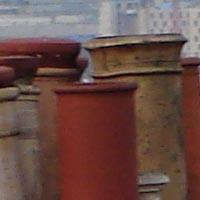 |
| 1/25th | 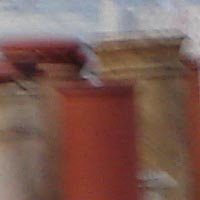 |
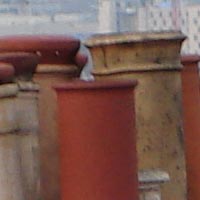 |
| 1/13th |  |
 |
As you can see, with image stabilisation turned off, I can just about handhold the camera and still obtain a fairly sharp shot down to about 1/50th second. With image stabilsation turned on, 1/25th sec doesn't look too bad, especially compared to the same shutter speed with stabilisation turned off. This feature does seem to make a difference and could mean the difference between capturing a successful, sharp shot or missing the opportunity altogether.
Overall Image Quality
The Sony Cyber-shot DSC-H1 produced images of above average quality during the review period. The 5 megapixel images were a little soft straight out of the camera and ideally require some further sharpening in an application like Adobe Photoshop, or increasing the in-camera sharpening level. The Sony Cyber-shot DSC-H1 dealt very well with chromatic aberrations, which hardly appeared in any of the test shots - limited purple fringing effects could only be seen in very high contrast situations. Macro performance is great, allowing you to focus as close as 2 cms away from the subject. The built-in flash worked well indoors with no red-eye and good overall exposure. The night photograph was very good too, with the maximum shutter speed of 30 seconds and automatic noise reduction offering lots of scope for creative night photography. Image stabilisation works well when hand-holding the camera in low-light conditions or when using the telephoto end of the zoom range, providing 1-2 stops advantage, and it's worth leaving this on most of the time. The Sony Cyber-shot DSC-H1's main drawback in terms of image quality, however, is noise. ISO 100 looks fine, but there's some noise starting to appear at ISO 200, which isn't exactly a quick speed, and ISO 400 is something of a last resort.
|
 PhotographyBLOG is a member of the DIWA organisation. Our test results for the Sony Cyber-shot DSC-H1 have been submitted to DIWA for comparison with test results for different samples of the same camera model supplied by other DIWA member sites.
PhotographyBLOG is a member of the DIWA organisation. Our test results for the Sony Cyber-shot DSC-H1 have been submitted to DIWA for comparison with test results for different samples of the same camera model supplied by other DIWA member sites.



